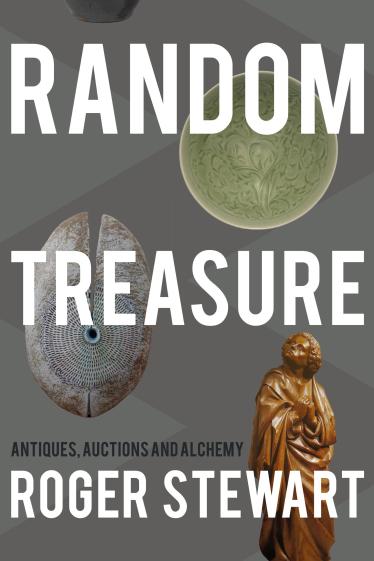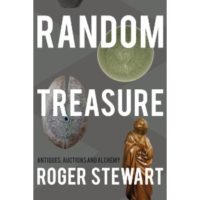Delightful book about the antiques market experience by a random collector
Random Treasure: Antiques, Auctions and Alchemy
by Roger Stewart
2017, Book Guild Publishing Ltd

This book was just delightful. I enjoyed the content, the structure, and the style, as well as every moment I spent reading it. The only thing that I disliked about this book is that I read it after I moved from Scotland as now convincing Roger Stewart to let me go with him to Edinburgh auctions and charity shops becomes more complicated. That said, if we ever get out of this horror show of a pandemic, Scotland is a place that I am very likely to be at any given time. Mr Stewart, if you are reading this, I can offer you enthusiastic company in return for a firsthand look at your experiences in this world.
Backing up a few steps, Random Treasure focuses on the personal experience of a mostly-collector sometimes-seller of old and curious things who is based in Edinburgh. Antiques and artworks are not his primary line of work, his purchases come from charity shops and 4th tier local auctions, and the amounts he spends on individual objects trend towards the double and low triple digits. Thus unlike the usual biographies about and memoirs of famous galerists, top auctioneers, or ultra-wealthy collectors, this book represents a realistic experience of engagement with the old, curious, and beautiful. Stewart’s evaluation of his own behaviour as a collector is insightful, interesting, and often quite amusing. All told, Random Treasure portrays an experience of collecting and market engagement that is much more closely aligned with the results of the various interviews I’ve conducted in my research than what the art world elite is willing to slap between book covers.
Am I going to cite the heck out of Random Treasure in future academic work? Oh, I am.
As I followed the delightfully convoluted-in-a-good-way narrative pathway that the author lays out for his main characters (a jug and a saint), I started thinking about my own engagement with the market structures that he and his two objects navigate: 1. charity shops, 2. local auctions, and 3. international auctions. On an academic level, my relative expertise in these venues runs 3, 2, 1: I have a lot of academic experience with auction houses and zero experience with charity shops. My personal experience, though, is a solid 1, 2, 3: I’m a charity shop pro but my auction experience falls quickly off a cliff. I have spent years of my life sifting through knickknacks, tat, and glorious trash at charity shops the world over. I can move at my own pace, the price is a clear sticker on the bottom of the thing, and stress levels are low. In contrast, I have made but two purchases at auction and I hated the process. The first was 14 years ago at the monthly auction of police-seized bicycles held at an ultra local auction house in Cambridgeshire: I needed a bike, I had no money, I had one shot to get something rideable as I had to get a difficult-to-find lift out to the village that this event took place in. I got a bike, but bidding on it nearly broke me. THE STRESS. The other time was via remote bidding at a Belgian auction house for a piece of mid-century Guatemalan art which I won but, again, THE STRESS.
Yet, by reading Random Treasure, I can see that there is another way of experiencing the auction. That the stress, the rush, the uncertainty, the pace might in itself be the very draw. I mean people like rollercoasters for some reason, right? I don’t, but I think that is my point. Random Treasure is a window into the collecting experience for someone who doesn’t experience it like me. As a sociologist who studies collecting, that’s gold.
Of particular interest to me was the author’s discussion of both provenance and research. He presents a wonderfully honest chapter discussing the reality of provenance research when one’s source of objects are either the local Salvation Army shop or an auctioneers that turns over thousands of low-value, barely-catalogued consignments each year of objects that may also have passed through several charity shops or the likes. Except in the case of the most unique, most high-value pieces, no one asks, no one tells. What is left, then, is research conducted by the buyer.
This research is at the core of Stewart’s collecting experience. The excuse to study an object that he has just bought, to learn from it, to dig into the history of its production and disbursement into the world is often why he buys a piece. This lines up exactly with interviews I’ve conducted with fossil collectors: each fossil is an excuse to take a deep dive in to the scientific study of the species in question and that engagement with the science is a large part of the appeal of collecting for most. The objects are not simply a physical or aesthetic experience, the objects bring with them an extensive back story and context that the collector gets to enjoy discovering. I can certainly relate to this.
I also enjoyed Stewart’s discussion of his engagement with experts concerning his object discoveries. I was really interested in the 50% response rate that he reports; half of the experts and academics he contacts about a piece that he is researching respond to him. I can’t quite tell if I think that is low or if it is high, but there is something about that number that I need to think more about. I’m curious why so many academics don’t respond: are they too busy; is it a aversion to providing expensive expertise for free when it should certainly be paid for (sorry Mr Stewart, you really should be paying them to add value to your stuff); is it a distaste for contributing to the commodification of culture? This makes me want to put out a survey to colleagues about how they respond to requests from the public for object opinions.
Me? This post sums up my stance:
Don’t ask me to authenticate antiquities for you (unless you’re the police)
Looking back over this review, I don’t think I’m selling this book properly. It’s witty and insightful, personal and useful. Reading it was a great way to spend a few hours and it has left me with some thinking to do. I’m going to enjoy that thinking just like the author enjoys his object research.
Perhaps more dangerously, Random Treasure has me considering a cycle ride to the local charity shop to have a closer look at the many, many ceramics available there. There is limited shelf space in my toddler proof house, but I am finding it hard to resist at least taking a look…
Once again, Mr Stewart, if you are reading this, coffee and cake on me if you’ll take me along to the auction house next time I’m in Scotland.
